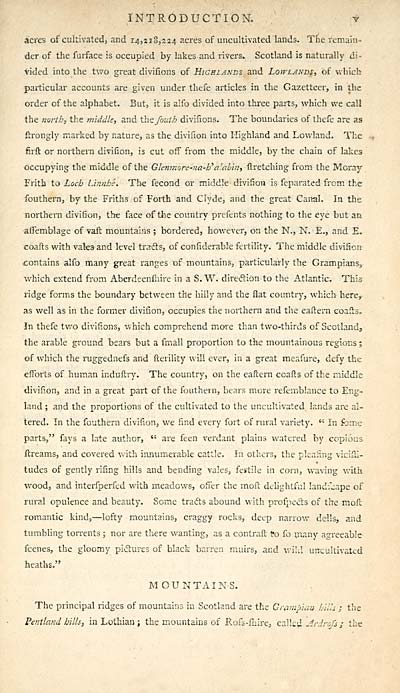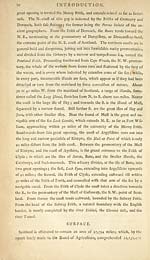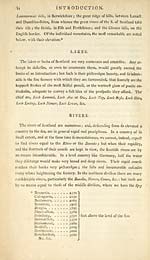Gazetteer of Scotland
(13) Page v
Download files
Complete book:
Individual page:
Thumbnail gallery: Grid view | List view

INTRODUCTION. v
acres of cultivated, and 14,218,224 acres of uncultivated lands. The remain-
der of the furface is occupied by lakes and rivers. Scotland is naturally di-
vided into the two great divifions of Highlands and Lowlands, of which
particular accounts are given under thefe articles in the Gazetteer, in the
order of the alphabet. But, it is alfo divided into three parts, which we call
the north, the middle, and the /out A divifions. The boundaries of thefe are as
irrongly marked by nature, as the divifion into Highland and Lowland. The ,
firft or northern divifion, is cut off from the middle, by the chain of lakes
occupying the middle of the Glenmore-na-b l 'a'.abin, ftretching from the Moray
Frith to Loch Linnhe. The fecond or middle divifion is feparated from the
fouthern, by the Friths of Forth and Clyde, and the great Canal. In the
northern divifion, the face of the country prefents nothing to the eye but an
afTemblage of vaft mountains ; bordered, however, on the N., N. E., and E.
coafts with vaka and level trails, of confiderable fertility. The middle divifion
contains alfo many great ranges of mountains, particularly the Grampians,
which extend from Aberdeenlliire in a S. W. direction to the Atlantic. This
ridge forms the boundary between the hilly and the flat country, which here,
as well as in the former divifion, occupies the northern and the eaftern coafts.
In thefe two divifions, which comprehend more than two-thirds of Scotland,
the arable ground bears but a fmall proportion to the mountainous regions ;
of which the ruggednefs and fterility will ever, in a great meafure, defy the
efforts of human induftry. The country, on the eaftern ccafts of the middle
divifion, and in a great part of the fouthern, bears more refemblance to Eng-
land ; and the proportions of the cultivated to the uncultivated lands are al-
tered. In the fouthern divifion, we find every fort of rural variety. " In fom-e
parts," fays a late author, " are feen verdant plains watered by copious
ilreams, and covered with innumerable cattle. In others, the pleaSng viciSi-
tudes of gently riling hills and bending vales, fertile in corn, waving with
wood, and interfperfed with meadows, offer the mod delightful landfcape of
rural opulence and beauty. Some tracts abound with profpecls of the moil
romantic kind, — lofty mountains, craggy rocks, deep narrow dells, and
tumbling torrents ; nor are there wanting, as a contrail to fo many agreeable
fcenes, the gloomy pictures of black barren muirs, and wild uncultivated
heaths."
MOUNTAINS.
The principal ridges of mountains in Scotland are the Grampian bills ; the
Penttand hills, in Lothian ; the mountains of Rofs-fiiire, called Ardrafs ; the
acres of cultivated, and 14,218,224 acres of uncultivated lands. The remain-
der of the furface is occupied by lakes and rivers. Scotland is naturally di-
vided into the two great divifions of Highlands and Lowlands, of which
particular accounts are given under thefe articles in the Gazetteer, in the
order of the alphabet. But, it is alfo divided into three parts, which we call
the north, the middle, and the /out A divifions. The boundaries of thefe are as
irrongly marked by nature, as the divifion into Highland and Lowland. The ,
firft or northern divifion, is cut off from the middle, by the chain of lakes
occupying the middle of the Glenmore-na-b l 'a'.abin, ftretching from the Moray
Frith to Loch Linnhe. The fecond or middle divifion is feparated from the
fouthern, by the Friths of Forth and Clyde, and the great Canal. In the
northern divifion, the face of the country prefents nothing to the eye but an
afTemblage of vaft mountains ; bordered, however, on the N., N. E., and E.
coafts with vaka and level trails, of confiderable fertility. The middle divifion
contains alfo many great ranges of mountains, particularly the Grampians,
which extend from Aberdeenlliire in a S. W. direction to the Atlantic. This
ridge forms the boundary between the hilly and the flat country, which here,
as well as in the former divifion, occupies the northern and the eaftern coafts.
In thefe two divifions, which comprehend more than two-thirds of Scotland,
the arable ground bears but a fmall proportion to the mountainous regions ;
of which the ruggednefs and fterility will ever, in a great meafure, defy the
efforts of human induftry. The country, on the eaftern ccafts of the middle
divifion, and in a great part of the fouthern, bears more refemblance to Eng-
land ; and the proportions of the cultivated to the uncultivated lands are al-
tered. In the fouthern divifion, we find every fort of rural variety. " In fom-e
parts," fays a late author, " are feen verdant plains watered by copious
ilreams, and covered with innumerable cattle. In others, the pleaSng viciSi-
tudes of gently riling hills and bending vales, fertile in corn, waving with
wood, and interfperfed with meadows, offer the mod delightful landfcape of
rural opulence and beauty. Some tracts abound with profpecls of the moil
romantic kind, — lofty mountains, craggy rocks, deep narrow dells, and
tumbling torrents ; nor are there wanting, as a contrail to fo many agreeable
fcenes, the gloomy pictures of black barren muirs, and wild uncultivated
heaths."
MOUNTAINS.
The principal ridges of mountains in Scotland are the Grampian bills ; the
Penttand hills, in Lothian ; the mountains of Rofs-fiiire, called Ardrafs ; the
Set display mode to: Large image | Transcription
Images and transcriptions on this page, including medium image downloads, may be used under the Creative Commons Attribution 4.0 International Licence unless otherwise stated. ![]()
| Gazetteers of Scotland, 1803-1901 > Gazetteer of Scotland > (13) Page v |
|---|
| Permanent URL | https://digital.nls.uk/97343584 |
|---|

